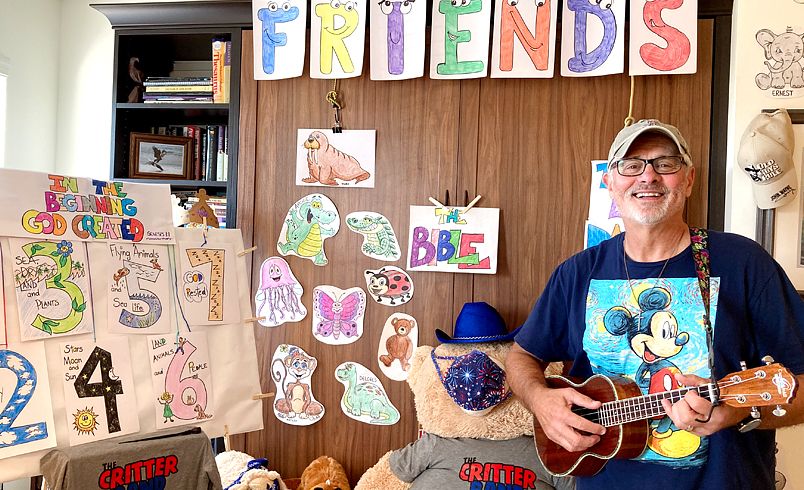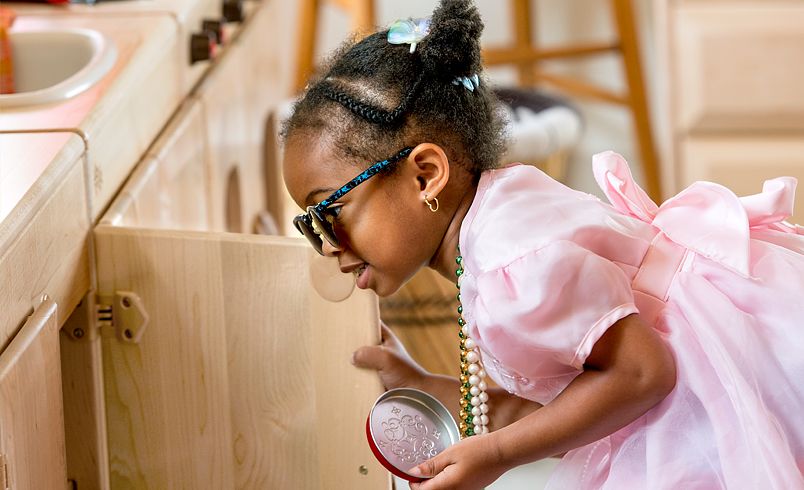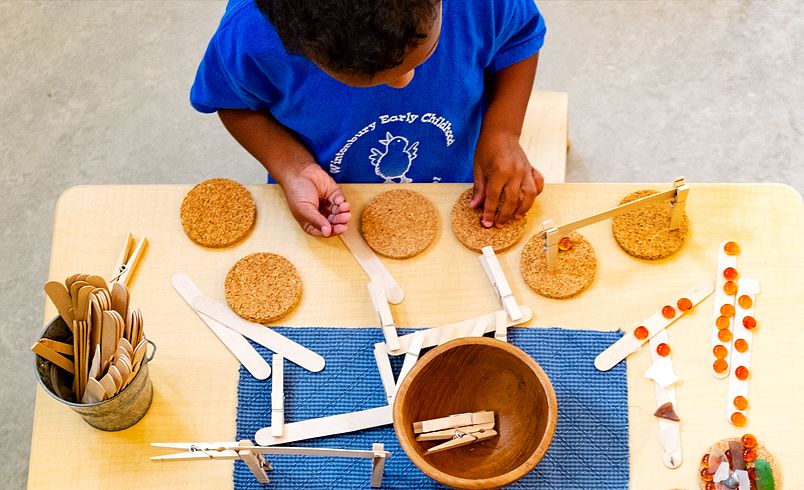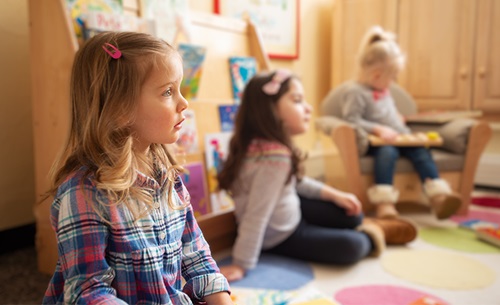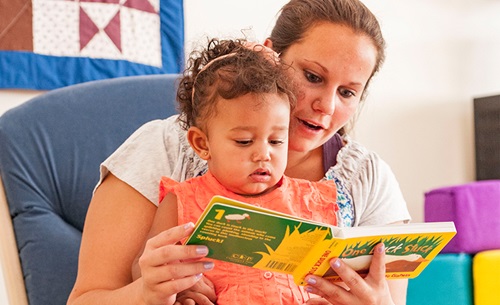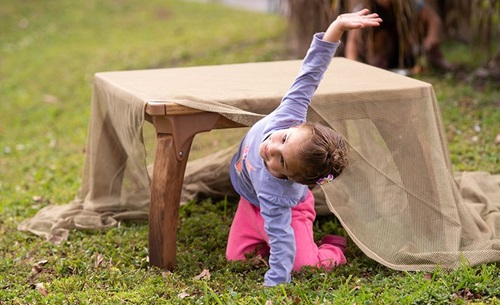Turning Challenges into Opportunities
Promoting Play in a Time of Virtual Learning
| October 2020Times of crisis are confusing and stressful. However, these moments can also present opportunities that help us adapt and grow. The unprecedented transition from classrooms to virtual learning in the last months can leave us feeling hopeless and powerless, or we can choose to use the moment as a catalyst to transform early childhood education. It is time to support children’s interests and ideas and promote play as the most important thing children can do to make sense of a confusing world.
We must take a moment to take stock of how incredible it is to belong to a profession with so much innovation, creativity, flexibility, and agility. Despite all the challenges that come our way we have fought to stay true to what we believe is best for children. We have persevered through higher accountability standards, increased paperwork, less time for children to play, and low wages. We have done it with grace, courage, and a profound care and empathy for children, families, and each other.
The COVID-19 crisis has now thrown new challenges our way, one of which is virtual learning. I am confident that we will be able to tackle this challenge with the creative thinking it demands. Can we still stay true to our belief that children learn best through play? We must!
Now is the time to reiterate our values as educators and as a profession. It is the time to focus on creating play opportunities, which we know is the best thing for children, particularly in crisis moments. I hope that this article will provide you with some simple ideas of how to transfer your beliefs in play-based learning to your current remote teaching situation. It is the time to make sustainable changes to the current educational system.
Children need to be able to trust their teacher. Educators need to be fully present, dynamic, and attuned when relating to children. While this is more difficult with remote teaching, children still need to know that the person they see on the screen cares about them. Virtual teaching requires more energy, a different tone of voice, and total understanding and compassion. Remember that you may be competing with many of the cartoon and television characters children love to watch.
It is crucial to build relationships to children and families. Remember that you are a guest in their home. Create a space where relationships can grow. Build meaningful connections to let them know that you care about their wellbeing. When educators are warm, approachable, joyful, and supportive, children’s capacities for autonomy, self-direction, and self-efficacy grow and develop.
Guide children in a way that preserves their own unique way of being in the world. Focus on their strengths and support their inner motivational capacities. Gentle educators rely on informational language rather than controlling language. They also allow children to communicate in their own way and make an effort to understand them. They encourage progress without focusing on perfection and are responsive to children’s suggestions and ideas. The more support children get in this way, the more creative and innovative they can be.
Avoid sending home rules that must be followed. Instead, let the parents know that you understand and respect that children may not be sitting in front of the screen during an entire lesson or activity. They may be playing, drawing, dancing, moving, or even upside down on the sofa while listening to what you are saying. These are acceptable behaviors and show that children are using their bodies to learn.
Define Your Purpose, Goals, and Values
We all share a higher purpose; we want children to play, learn, grow, and thrive regardless of whether they have access to in-person learning or not. We all agree that what is best for children is to go to their early childhood programs and spend time with peers and caring adults. However, this may not be the current reality for many children due to health and safety issues.
We know that as educators our first responsibility is to children and families. Focus on their wellbeing and mental health rather than attempting to meet all curricular expectations. Families and children are currently stressed and dealing with many challenges. This is a time when we must promote play as the most important thing for children to do. Children need to process what they are experiencing and living, and play will help them do this. Virtual learning needs to be stress-free and have a clear focus on play and less screen time that tires children and creates discord in families.
Revisit your course goals with a focus on what is essential. Decide on the knowledge children need to acquire and what skills they need to develop over the course of the next year. Do you want them to memorize the letters and the numbers, or do you want them to play with language and mathematize as they play? The second choice is less stressful and more joyful. By defining your goals and values, you will be able to plan your virtual learning opportunities more effectively.
Children are innately curious and motivated to learn. How engaged they are when they are virtually learning depends on the supportive quality of the educator. When there is a precise balance between providing guidance and giving children the autonomy to explore their ideas and intent, they will be more engaged. Many children have an inherent motivational compass. This compass includes their intrinsic needs for autonomy, competence, and belonging. It also includes internalized resources such as interest, preferences, ideas, and values. When educators are attuned to their students by being fully present, they can create engaging virtual lessons that fully promote learning. (Reese, 2006).
Trust that children are the protagonist of their knowledge and will engage in play without adults to direct them every step of the way. Knowing this can help you establish a balanced schedule as you plan your week with children. Decide when you will invite all children to a group gathering and when you can give children play opportunities to engage with at home.
Nurture children’s inner motivational resources, their ideas, and their interests. Offer children choices, materials, and activities with multiple affordances, a sense of enjoyment, a sense of challenge, and ample opportunities for meaning-making. Invite families to collect loose parts around the house that children can use to build, design, create, and explore their feelings and ideas. Send a list of ideas to families, with suggestions to find loose parts at home that children can use in their play, include an explanation of the skills, knowledge, and dispositions children learn will engage families in supporting their children's play.
- Select activities that are relevant and meaningful to children and communicate the value of these activities to families. Plan for opportunities that encourage different perspectives. Recognize that children may feel differently about other people’s ideas can help educators negotiate thoughts and feelings in a way that further engages students.
- Acknowledge, encourage, and accept different ideas and a variety of answers to questions. Focus on creating intriguing explorations to do at home, rather than workbooks and worksheets that require a right or wrong answer.
- Listen carefully to children’s ideas, interests, and feelings. Like us adults, children have a profound need to be heard and to have their feelings acknowledged. We are experiencing difficult times, and they need caring and understanding adults to guide them. You can send ideas for families to create opportunities for dramatic play. For example, small worlds can be easily created in small spaces. A box with scarves, headbands, and fabric can produce hours of dramatic play that will help children process what they are feeling. You can have them share photos and dictate stories of their explorations.
- Celebrate the unique ways children learn. Expecting children to be in front of the screen for a long time is counterproductive. Every child is unique, so designing a well-balanced delivery plan can support the different ways children learn. For instance, have a consistent morning welcome that children enjoy; a song, a good morning share, or fingerplays can set the day’s tone. You can then invite the children to engage in a play exploration at home. Later in the day, they can gather again to share what they did. After lunch, you can gather again to read a book together. Keep your opening and closing consistent but be flexible with what happens in other parts of the schedule. You can also tape book readings and make them available to watch throughout the day.
- Provide multiple opportunities for children to actively engage with materials, such as loose parts to play, build design, and create. Sending a list of loose parts to families with the intent and purpose of what children learn as they play can further support engagement and help families focus on the importance of play instead of thinking that their children are falling academically behind.
As challenging as it sounds transitioning to virtual teaching, educators can still continue to creatively deliver meaningful learning that engages children in self-directed and self-sustaining play.
Learn more at: https://www.playfultransformation.com/
References:
Reeve, J. (2006). Teachers as Facilitators: What Autonomy‐Supportive Teachers Do and Why Their Students Benefit. The Elementary School Journal, 106(3), 225-236. doi:10.1086/501484


